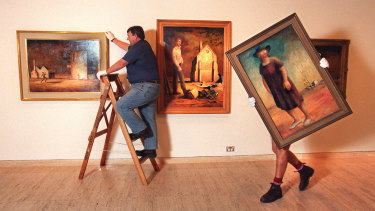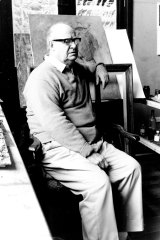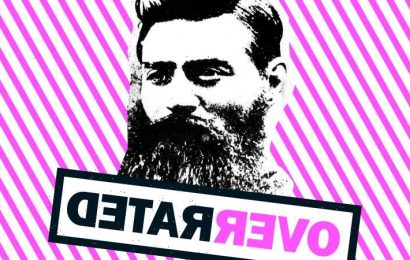First published in The Age on June 30, 1981
Drysdale: outback visionary
Sir Russell Drysdale, who died yesterday aged 69, will be remembered as the artist who for more than two decades impressed into the Australian consciousness his own strong, idiosyncratic image of the Australian outback.
Gallery staff hang paintings by Russell Drysdale (L-R The Cricketers, Picture of Donald Friend and Woman in a Landscape) for a major retrospective at the Art Gallery of NSW on March 25, 1998.Credit:Robert Pearce
It is his classic paintings and drawings of the 1940s that assure Drysdale a permanent place in the history of our art. He ventured into a largely unrecorded landscape the Heidelberg School did not want to know, and helped shape our image of our country.
As Robert Hughes once wrote, “Drysdale’s true success lies in constructing a coherent, self-enclosed world of bodily experience, so well laid out that 20 years of laymen and painters in Australia would have had a struggle not to think of their country’s shape in terms of his paintings.”
He was the most hospitable and friendly of men, but had about him a certain reserve. His friend the novelist Murray Bail wrote of him earlier this year: “He is a man of curiously little vanity. Also — and I suggest this warily — I don’t think he is much given to introspection.
“Other symptoms of this may be found in his reading habits. Most unusual for a painter, he is an omnivorous reader, but of Australian and European history, biographies, zoology, archaeology, ornithology, ‘Scientific American’, and some art. As for poetry, philosophy or fiction — never . . . He is happier with facts and intimacy is difficult.”
For the past 17 years he lived in the hills outside Sydney, in a house designed by the Melbourne architect, Guildford Bell.
He was appointed in 1962 a member of the Commonwealth Art Advisory Board, and showed himself a skilled negotiator in buying works of art for the national collection in Canberra; skills reinforced by years at the boardroom table of his family sugar business in Queensland.
Sir Russell Drysdale pictured at his home, Bouddi Farm, near Gosford on August 9, 1979.Credit:Robert Pearce
Although he had made drawings from an early age Russell Drysdale showed little interest in art at school and seemed destined for a future on the land —his parents having acquired a pastoral property, Boxwood Park, in the Riverina district in 1926.
Sir Russell was born in Bognor Regis, Sussex, England in 1912 and came to Australia as a child with his family in 1923.
The Drysdales had had family associations with early Australian pioneers and pastoralists from as far back as the 1820s. The Russell and Drysdale families established themselves first in Tasmania, then in the Western District of Victoria, the Riverina and north Queensland.
Sir Russell entered the art world at the age of 20, when he was in hospital in Melbourne for an operation on his left eye. Several drawings he had done impressed a doctor, Dr Julian Smith, who introduced him to Daryl Lindsay. Through Lindsay he met influential art teacher George Bell, who made Drysdale aware of contemporary European art and the possibility of art as a profession.
On a trip to England and Europe in the same year Drysdale experienced modern painting at first-hand and returned to Australia with serious thoughts of giving up the land for art.
In 1935, he married Elizabeth (Bonny) Stephen, also of Scottish descent, settled in Melbourne and enrolled as a student at the Bell Shore School (later the George Bell School) where he renewed his friendship with a former schoolmate, the painter Peter Purves Smith, whose quirky brand of social comment and sup realism was later assimilated into his own style. (Drysdale married Purves Smith’s widow, Maisie, in 1964 after the death of his first wife in 1963.)
While a student of Bell’s he worked through various styles associated with the School of Paris. He experimented with cubism in the still lifes of 1938-39, but was particularly attracted to the smooth, mannered simplifications of figures in paintings by School of Paris artists Modigliani and Kisling.
In ‘The Rabbiter and his Family’, painted in 1938, he is still very much concerned with decorative pattern and a sophisticated naiveté derived from the work of English artist Christopher Wood, but the painting’s elongated figures of the “country types” seem to predict the shape and subject of paintings to come.
The early years of World War II saw an acceleration of Drysdale’s development and the strengthening of his art. He was unacceptable for war service because of impaired eyesight In the early 1940s, he moved away from the decorative Post-Impressionism of his student days towards a type of Australian regionalism.
The new paintings were reminiscent, though not necessarily influenced by, American regionalists of the 1930s such as Thomas Hart Benton and John Stuart Curry (and certain paintings by Alexander Brook). As well as elongated figures and a focus on the harshness of the land, both Drysdale and the American regionalists firmly rejected their youthful apprenticeship to the School of Paris.
The war years were just the right climate to prolong the surrealist movement and it is clear from ‘The Rabbiters’ and The Drover’s Wife’ and other well-known paintings of the period that Drysdale had arrived at a new vision of the Australian landscape — one from which figures are rarely absent — by absorbing the surrealist-inspired transformations of nature by the English artists Paul Nash, Graham Sutherland and Henry Moore.
Low horizon lines and deep perspectives accentuate the isolation of country life. As Patrick McCaughey has written “the paintings and drawing of this period have both the luminosity of the dream and the grit of reality”.
Drysdale was a flee draftsman who drew continuously throughout his life. There is no doubt that his drawings and sketches are the most consistent aspect of his art.
As a student of George Bell he learnt to draw from memory, so that in the most direct and spontaneous-looking sketches the essence of his subject — a gallery of country “characters” is distilled by contemplation and a remarkable power of recall.
Drysdale’s most powerful images are rooted in the common-place — men as lean as the naked trees fossick and hunt rabbits, children play among household debris and solid women stand silent and earth-bound. This is the Drysdale image that will persist: the most powerful image of the Australian outback of its time. Sidney Nolan summed him up. “Drysdale is the most Australian of us all.”
Most Viewed in Culture
From our partners
Source: Read Full Article









